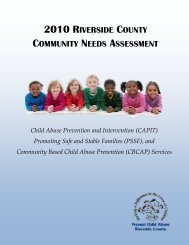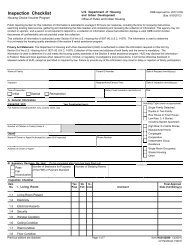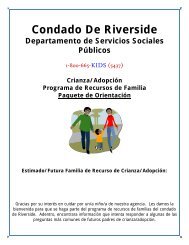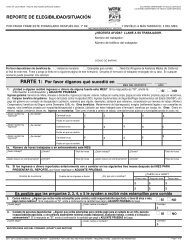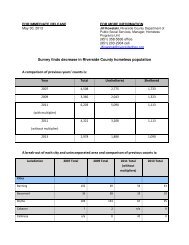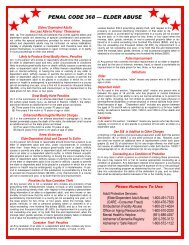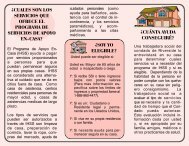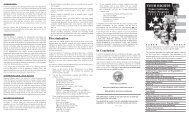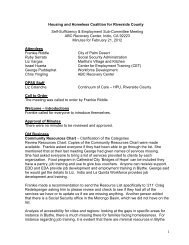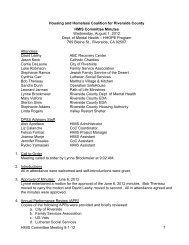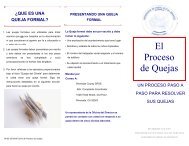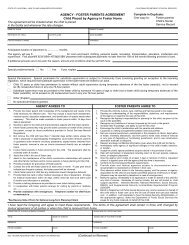DPSS 3300 - Riverside County Department of Public Social Services
DPSS 3300 - Riverside County Department of Public Social Services
DPSS 3300 - Riverside County Department of Public Social Services
Create successful ePaper yourself
Turn your PDF publications into a flip-book with our unique Google optimized e-Paper software.
<strong>Riverside</strong> <strong>County</strong> <strong>Department</strong> <strong>of</strong> <strong>Public</strong> <strong>Social</strong> <strong>Services</strong> – Children’s <strong>Services</strong><br />
Visitation Plan Evaluation – <strong>DPSS</strong> <strong>3300</strong><br />
CWS/CMS Referral #: CWS/CMS Child Case #: Today’s Date:<br />
Mother’s Name: DOB:<br />
Address: Mother’s Phone:<br />
Father’s Name: DOB:<br />
Address: Father’s Phone:<br />
Eldest Child’s Name: DOB:<br />
Address: Child’s Phone:<br />
CSSW Name: CSSW Phone: J#: Service Component:<br />
SSA/SW Name: SSA/SW Phone: Indicate who supervised: CSSW SW SSA<br />
Location: Start Time: End Time:<br />
Visiting Child(ren)’s:<br />
Visiting Parent’(s) Name:<br />
Scheduled Visit: Yes No Visitation Order: Yes No<br />
QUANTITY OF VISITS<br />
The parent is scheduled today and is ready for the visit Yes No<br />
The parent is scheduled today but missed the visit Yes No<br />
The parent called to advise they were unable to attend Yes No N/A<br />
The parent requested to reschedule the visit Yes No<br />
Comment:<br />
QUALITY OF VISITS<br />
Strong As Evidenced by Consistently<br />
Parent(s) Name:<br />
demonstrates parental role<br />
Child(ren’s) Name(s):<br />
redirecting the child(ren)<br />
providing nurturance<br />
engaging the child(ren) in problem solving<br />
other:<br />
<strong>DPSS</strong> <strong>3300</strong> (04/09) Visitation Plan Evaluation Page 1 <strong>of</strong> 6
<strong>Riverside</strong> <strong>County</strong> <strong>Department</strong> <strong>of</strong> <strong>Public</strong> <strong>Social</strong> <strong>Services</strong> – Children’s <strong>Services</strong><br />
Visitation Plan Evaluation – <strong>DPSS</strong> <strong>3300</strong><br />
Strong, Continued As Evidenced by Consistently<br />
Parent(s) Name:<br />
demonstrates knowledge <strong>of</strong> child’s development<br />
responds appropriately to child’s verbal/non verbal signals<br />
puts child’s needs ahead <strong>of</strong> their own<br />
shows empathy toward child<br />
Adequate<br />
Parent(s) Name:<br />
demonstrates parental role<br />
Child(ren’s) Name(s):<br />
using age appropriate expectations<br />
responding to child(ren)’s physical and emotional needs<br />
<strong>DPSS</strong> <strong>3300</strong> (04/09) Visitation Plan Evaluation Page 2 <strong>of</strong> 6<br />
other:<br />
engaging the child verbally or non verbally<br />
initiating eye contact<br />
holding or hugging the child<br />
other:<br />
providing emotional comfort to the child<br />
reassuring the child about their well-being<br />
other:<br />
demonstrating awareness <strong>of</strong> child’s emotions<br />
asking the child about their current feelings<br />
acknowledging appropriateness <strong>of</strong> child’s feelings<br />
other:<br />
As Evidenced by Occasionally<br />
Child(ren’s) Name(s):<br />
redirecting the child(ren)<br />
providing nurturance<br />
engaging the child(ren) in problem solving<br />
other:
<strong>Riverside</strong> <strong>County</strong> <strong>Department</strong> <strong>of</strong> <strong>Public</strong> <strong>Social</strong> <strong>Services</strong> – Children’s <strong>Services</strong><br />
Visitation Plan Evaluation – <strong>DPSS</strong> <strong>3300</strong><br />
Adequate, Continued As Evidenced by Occasionally<br />
Parent(s) Name:<br />
demonstrates knowledge <strong>of</strong> child’s development<br />
responds appropriately to child’s verbal/non verbal signals<br />
puts child’s needs ahead <strong>of</strong> their own<br />
shows empathy toward child<br />
Child(ren’s) Name(s):<br />
using age appropriate expectations<br />
responding to child(ren)’s physical and emotional needs<br />
other:<br />
engaging the child verbally or non verbally<br />
initiating eye contact<br />
holding or hugging the child<br />
other:<br />
providing emotional comfort to the child<br />
reassuring the child about their well-being<br />
<strong>DPSS</strong> <strong>3300</strong> (04/09) Visitation Plan Evaluation Page 3 <strong>of</strong> 6<br />
other:<br />
demonstrating awareness <strong>of</strong> child’s emotions<br />
asking the child about their current feelings<br />
acknowledging appropriateness <strong>of</strong> child’s feelings<br />
other:
<strong>Riverside</strong> <strong>County</strong> <strong>Department</strong> <strong>of</strong> <strong>Public</strong> <strong>Social</strong> <strong>Services</strong> – Children’s <strong>Services</strong><br />
Visitation Plan Evaluation – <strong>DPSS</strong> <strong>3300</strong><br />
Limited As Evidenced by Rarely<br />
Parent(s) Name:<br />
demonstrates parental role<br />
demonstrates knowledge <strong>of</strong> child’s development<br />
responds appropriately to child’s verbal/non verbal signals<br />
puts child’s needs ahead <strong>of</strong> their own<br />
shows empathy toward child<br />
Child(ren’s) Name(s):<br />
redirecting the child(ren)<br />
providing nurturance<br />
engaging the child(ren) in problem solving<br />
other:<br />
using age appropriate expectations<br />
responding to child(ren)’s physical and emotional needs<br />
other:<br />
engaging the child verbally or non verbally<br />
initiating eye contact<br />
holding or hugging the child<br />
other:<br />
providing emotional comfort to the child<br />
reassuring the child about their well-being<br />
<strong>DPSS</strong> <strong>3300</strong> (04/09) Visitation Plan Evaluation Page 4 <strong>of</strong> 6<br />
other:<br />
demonstrating awareness <strong>of</strong> child’s emotions<br />
asking the child about their current feelings<br />
acknowledging appropriateness <strong>of</strong> child’s feelings<br />
other:
<strong>Riverside</strong> <strong>County</strong> <strong>Department</strong> <strong>of</strong> <strong>Public</strong> <strong>Social</strong> <strong>Services</strong> – Children’s <strong>Services</strong><br />
Visitation Plan Evaluation – <strong>DPSS</strong> <strong>3300</strong><br />
Destructive As Evidenced by Never<br />
Parent(s) Name:<br />
demonstrates parental role<br />
demonstrates knowledge <strong>of</strong> child’s development<br />
responds appropriately to child’s verbal/non verbal signals<br />
puts child’s needs ahead <strong>of</strong> their own<br />
shows empathy toward child<br />
Child(ren’s) Name(s):<br />
redirecting the child(ren)<br />
providing nurturance<br />
engaging the child(ren) in problem solving<br />
other:<br />
using age appropriate expectations<br />
responding to child(ren)’s physical and emotional need<br />
<strong>DPSS</strong> <strong>3300</strong> (04/09) Visitation Plan Evaluation Page 5 <strong>of</strong> 6<br />
other:<br />
engaging the child verbally or non verbally<br />
initiating eye contact<br />
holding or hugging the child<br />
other:<br />
providing emotional comfort to the child<br />
reassuring the child about their well-being<br />
other:<br />
demonstrating awareness <strong>of</strong> child’s emotions<br />
asking the child about their current feelings<br />
acknowledging appropriateness <strong>of</strong> child’s feelings<br />
other:
Child(ren)’s demeanor at the beginning <strong>of</strong> the visit<br />
1.<br />
2.<br />
3.<br />
4.<br />
5.<br />
<strong>Riverside</strong> <strong>County</strong> <strong>Department</strong> <strong>of</strong> <strong>Public</strong> <strong>Social</strong> <strong>Services</strong> – Children’s <strong>Services</strong><br />
Visitation Plan Evaluation – <strong>DPSS</strong> <strong>3300</strong><br />
Child’s Name Happy Sad Mad Glad Anxious Other<br />
Child(ren)’s demeanor at the end <strong>of</strong> the visit<br />
1.<br />
2.<br />
3.<br />
4.<br />
5.<br />
Comments:<br />
Child’s Name Happy Sad Mad Glad Anxious Other<br />
<strong>DPSS</strong> <strong>3300</strong> (04/09) Visitation Plan Evaluation Page 6 <strong>of</strong> 6



